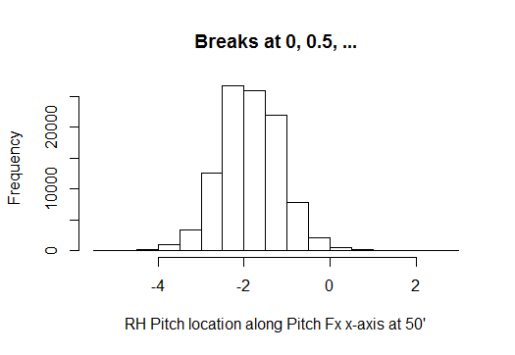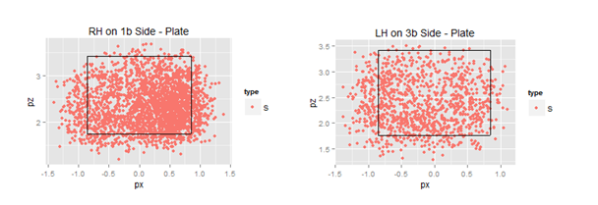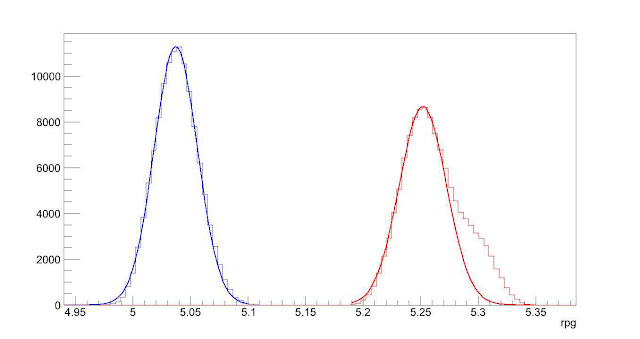For hitters, BABIP is often an explanation for unusually good or bad seasons. But what causes a great or poor BABIP? And are we right to simply blame BABIP whenever a bizarre season happens? It might help to look at some extreme cases. Even if we don’t learn something about how to interpret hitters’ BABIP, we can at least have fun. Nerdy, nerdy fun.
What is BABIP?
Batting average on balls in play is exactly that: when you hit the ball and it’s not a home run, what’s your batting average? Imagine you’d only ever batted twice; first you hit a single and then you struck out. Your BABIP would be 1.000. If a single and a groundout, .500. After seven games of the 2013 season, Rick Ankiel had two home runs but no singles, doubles, or triples, so his BABIP was .000.
Across any given season, the average BABIP tends to be about .300. All this means is that, when you hit the ball at professional defenders, there’s a 70% chance they’ll get you out.
What influences BABIP?
– The enemy. Defense and to some extent pitching are factors, but over the course of a full year, as you face the entire league, this averages out.
– Power. If you hit twenty balls to the warning track, and a lot of them fall for hits, your BABIP will increase. But if they all carry right over the fence for home runs, they will stop counting for this purpose, meaning your BABIP will probably decrease since more of your hits will be excluded from the stat.
– Hitting style. There are six infielders, so more ground balls tend to be fielded; this is why pitchers, who are wimpy at hitting, tend to have low BABIPs. Fly balls are often caught, so the best scores go to line-drive hitters.
– Speed. If you’re fast enough to beat throws and bunt for singles, your BABIP will be higher. If you run like I do, probably not so much.
– Luck. Maybe the biggest single factor is: are you lucky? We all see hard-hit balls straight at defenders, or guys who go on “hot streaks” where the ball “finds all the holes.” That’s called “luck,” and BABIP can quantify it. Believe it or not, you really can have good or bad luck that lasts an entire year.
Let’s illustrate these principles by looking at some hitters with very low BABIPs.
The Ten Lowest BABIPs Since 1945
10. Roger Maris, 1961 (.209). 38.4% of Roger Maris’ hits that year were home runs. (Stop now to think about that.) If the ball stayed in the park, somebody probably caught it. On the other hand, if the ball had a chance of leaving the park, it did. 61 of them did.
9. Jim King, 1963 (.208). Although somewhat powerful (24 homers), Jim King was also something else: bad. His BABIP never came close to league average, and in partial seasons after ’63 it would be .207 and .209. He was known as a power-hitting bench bat, and only found regular playing time on the miserable Washington Senators (106 losses that year).
8. Dave Kingman, 1982 (.207). Dave Kingman hit homers (37) and struck out a whole lot, and based on his terrible, terrible fielding metrics, he was a mighty slow fellow. There’s also another factor here: he was old. “But he was only 33,” you say. “If there was something to this age thing, he’d get worse as he got even older.” “Aha,” I reply, “that’s why you’re supposed to keep reading!”
7. Dick McAuliffe, 1971 (.206). Here’s our first plausible “bad luck” guy. A career .264 BABIP, and indeed the following year he had a .264 BABIP. A career .247 hitter, and the following year he hit .240. A career .343 OBP, and the following year his OBP was .339. So Dick McAuliffe bounced back just fine, but it’s worth noting two things: first, a career .247 hitter is not that good, and second, for whatever reason his walk rate did decline sharply during his “unlucky” year. Was he swinging more aggressively? If so, he was still striking out less than usual.
6. Roy Cullenbine, 1947 (.206). I mentioned Roy Cullenbine in my first post on these venerable pages: a man who combined all-time bad luck with a truly incredible batting eye, walking 22.6% of the time despite being a distinctly non-intimidating hitter. The only guy in 1947 who walked more was Triple Crown winner Ted Williams, and Williams was frequently being walked on purpose. Cullenbine’s possibly all-time-great ability to take a walk was rewarded with–well, never playing in another major league game.
He did hit 24 homers, but this is another bad luck year. Heck, Cullenbine’s BABIP in 1946 was .347.
5. Dave Kingman, 1986 (.204). Toldja so! Here’s Kingman, age 37, hitting home runs (35) but nothing else. A full-time DH by now, he (like Cullenbine) never played in the big leagues again.
4. Brooks Robinson, 1975 (.204). Only six home runs to his name, still manning third base, Brooks Robinson is another example of what’s becoming a clear trend: he was 38 years old. He played partial seasons after this, but not full ones. This was a truly godawful year: .201/.267/.274, good for a wRC+ of 54.
3. Ted Simmons, 1981 (.200). A catcher and a fairly slow runner turning 32, Simmons saw a small drop in power, which he partially recovered the next year, and a 97-point drop in his BABIP, hard to explain just from the power outage. The traditional explanation for his poor 1981 is that he had just moved to Milwaukee and the American League. Luck might have hurt him, too.
2. Curt Blefary, 1968 (.198). Carson Cistulli previously highlighted Blefary on this site. After winning Rookie of the Year in 1965, the young outfielder posted two more above-average seasons before falling off a metaphorical cliff in 1968. He was being bounced around between positions, and he was never a speedster: his defense inspired the nicknames Clank and Buffalo.
Part of it must be bad luck. The BABIP .045 below his career average bounced back in 1969, when he moved to catcher and had a fairly good season for the Astros; a power decline turned out to be real, but his other numbers recovered. And yet Blefary would play his last major league game at age 29, moving on to a career as a “sheriff, bartender, truck driver, and night club owner.”
1. Aaron Hill, 2010 (.196). Aaron Hill’s notoriously lost season is the only one here from the last twenty-five years–and the most dramatic of all. Interestingly, a RotoGraphs article on Hill attributes his 2010 to pure awfulness but his recovery in 2011 to an “inflated” BABIP. But a .196 BABIP, a full hundred points below average, counts as deflated, right? Hill sucked in 2010 despite 26 homers and a slightly increased walk rate.
The advantage of recency is that we have more data. Here the culprit is obvious: he had previously been, and would soon be again, very good at hitting line drives, but in 2010 his line-drive percentage dropped by half (just 10.6%) and more than half of the balls he hit all year became fly balls. Some of those drifted out of the park, but most drifted over a waiting defender. And even though Hill was walking more, he was also swinging more frequently at pitches outside the strike zone. Hill’s new approach in 2010 didn’t hurt his ability to take a walk, but it hurt his ability to drive the ball. Still, to earn the lowest BABIP in modern history, he also suffered from an entire season of some of the worst luck any batter’s ever had.
Conclusion
The BABIP losers here didn’t do badly over their careers: combined, these “bottom 10” earned 42 All-Star appearances (18 by Brooks Robinson), 3 MVP awards, and a Rookie of the Year prize.
This unscientific survey confirms a lot of preconceived ideas:
– slower players don’t create their own luck on balls hit in fair territory
– aging players often lose their speed or power or both
– swinging at balls outside the strike zone means you make inferior contact
– sometimes, good luck isn’t enough to save a terrible hitter
– sometimes, terrible luck is enough to end a good hitter’s career
But there’s an interesting question to be raised here. Some of these guys–Maris, Kingman–hit homers like crazy, thus suppressing their BABIPs. On the other hand, Blefary and Simmons lost home run power in their hard-luck years. Simmons was playing in a new ballpark and Blefary at a new position. Maybe they were the Aaron Hills of their times, adjusting their approaches in deleterious ways (probably swinging at more pitches). Maybe they hit the ball poorly for unknown, reversible reasons. Maybe they had bad luck.
If I were counseling hitters on how to maximize their batting average on balls in play, I would say this: cultivate speed and athleticism, swing at better pitches, and try to hit line drives. I don’t know if BABIP can or should be learned, however. Ultimately, BABIP is the baseball version of a zen koan or hippie bumper sticker. BABIP: Stuff Happens. Or, more accurately, sometimes in baseball you make your own fate, but sometimes your fate makes you.




